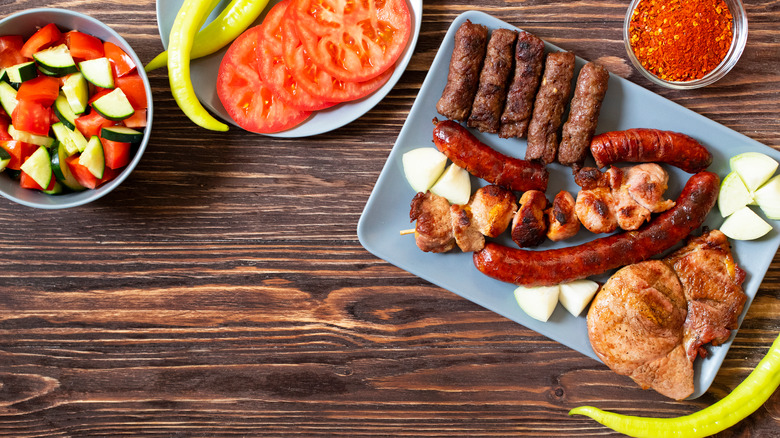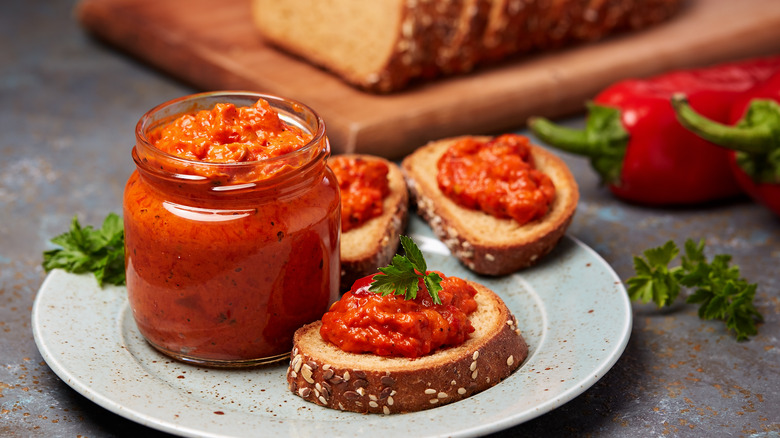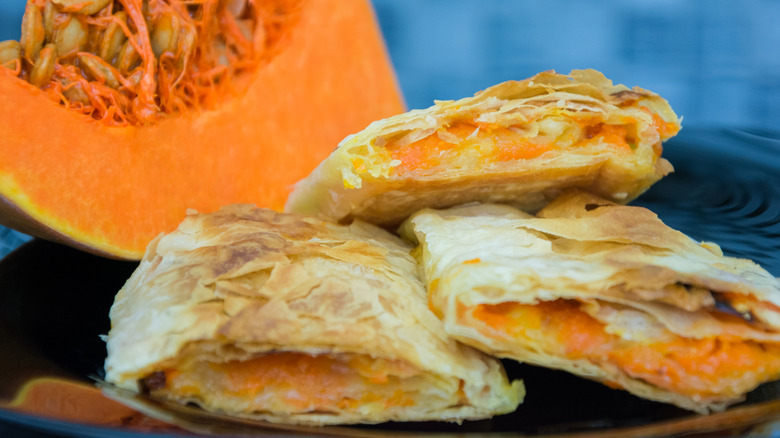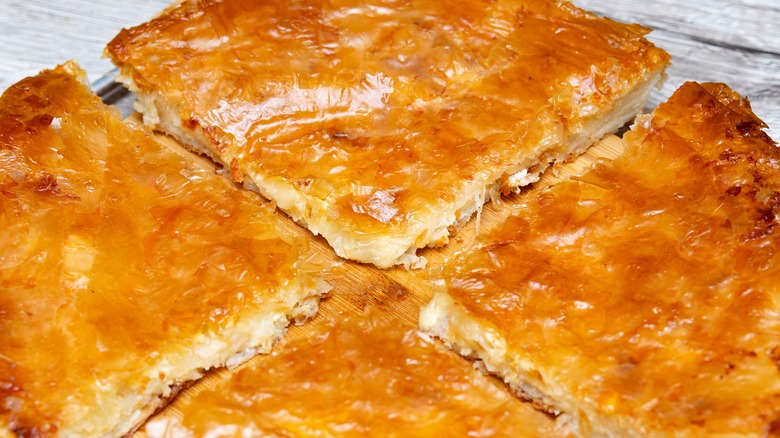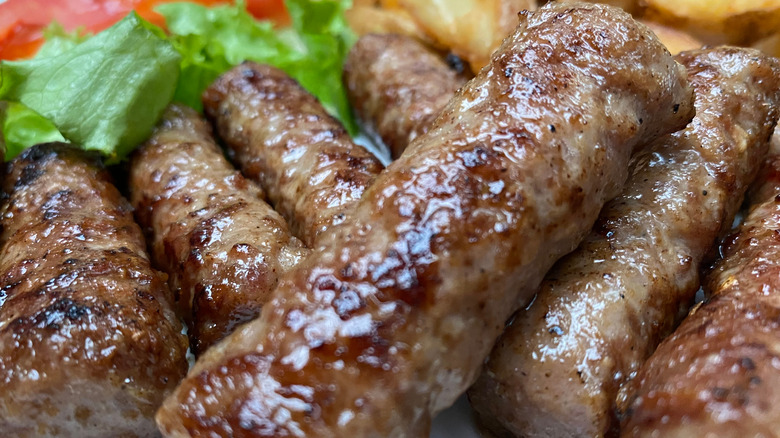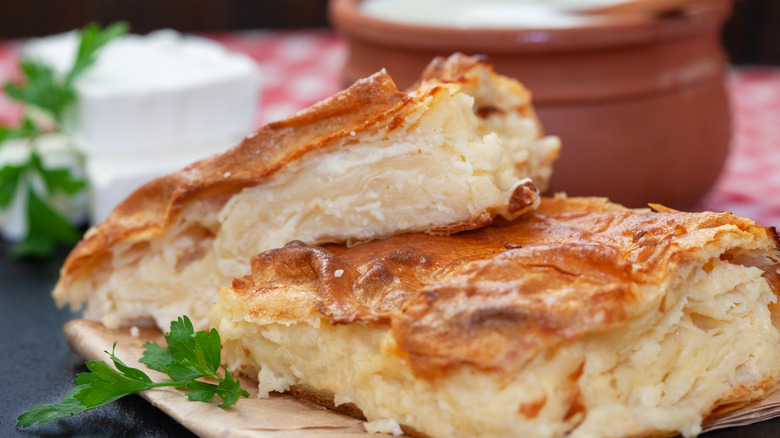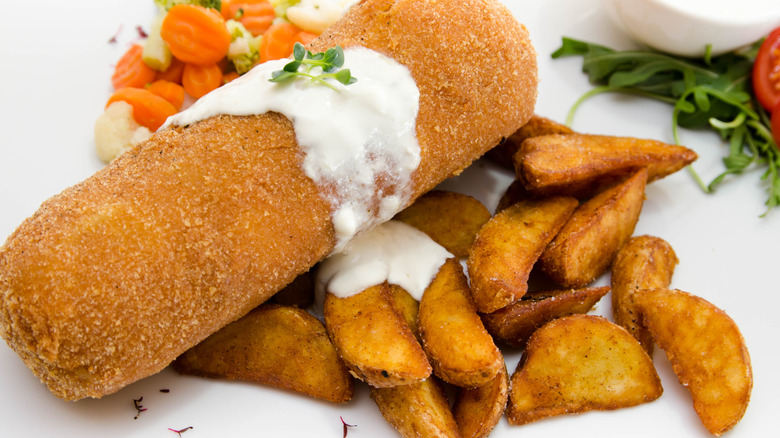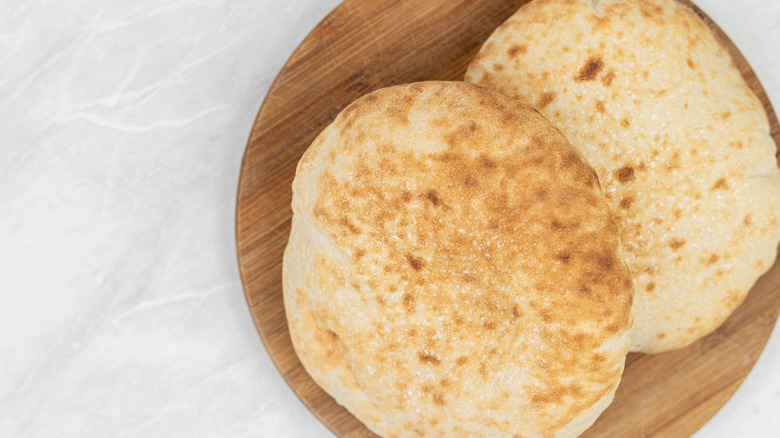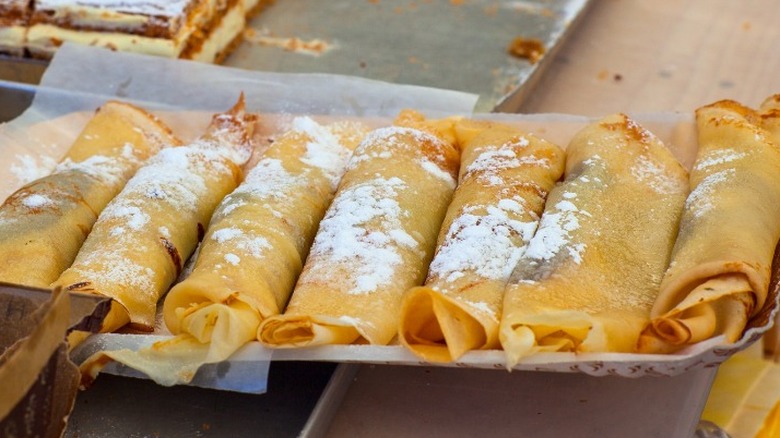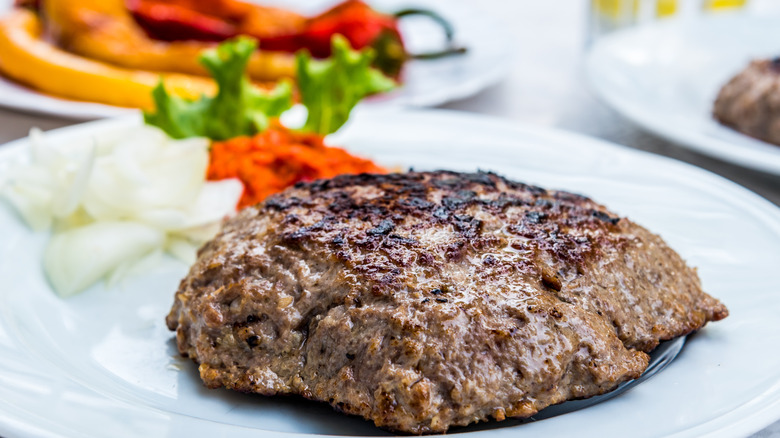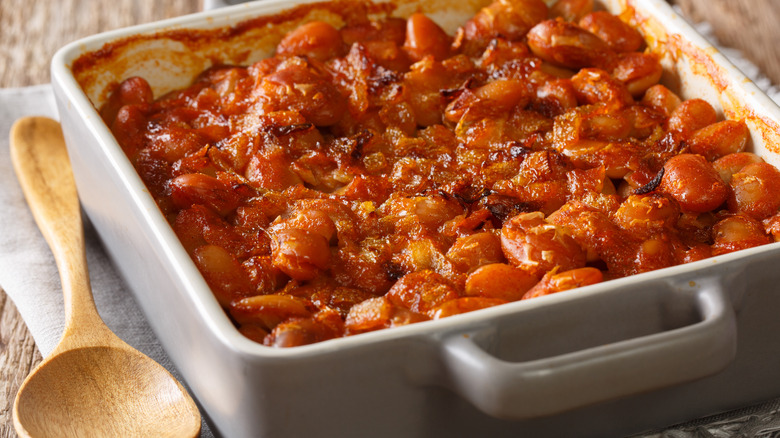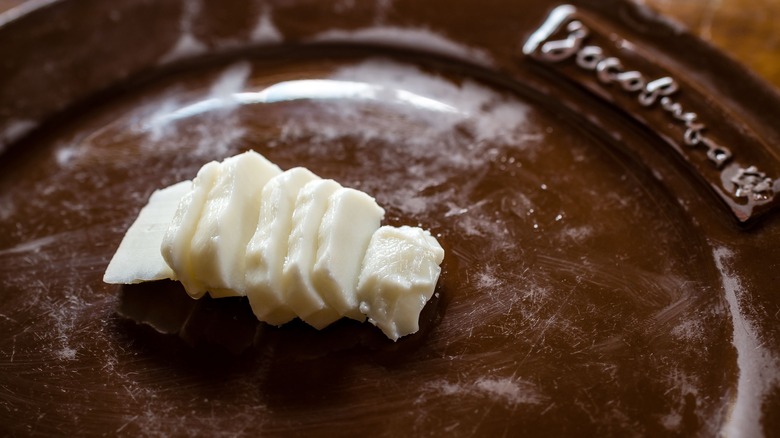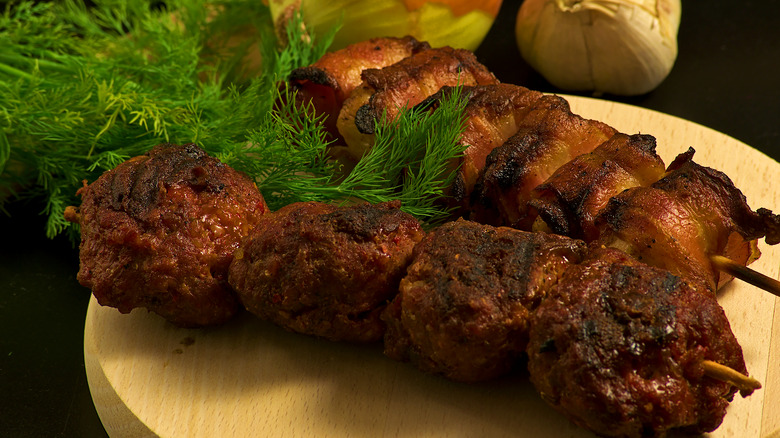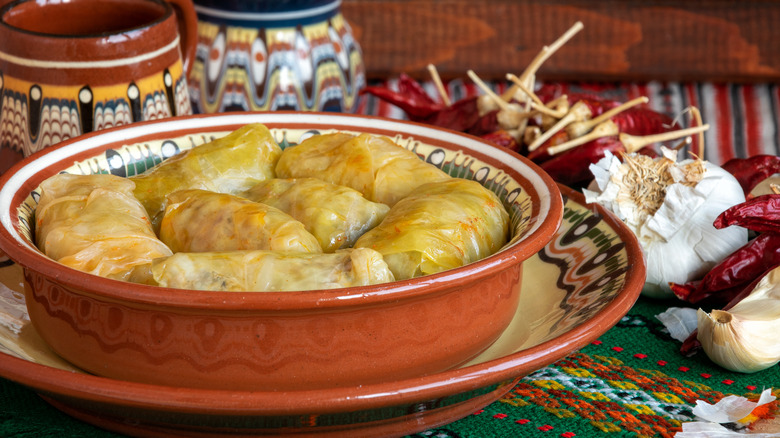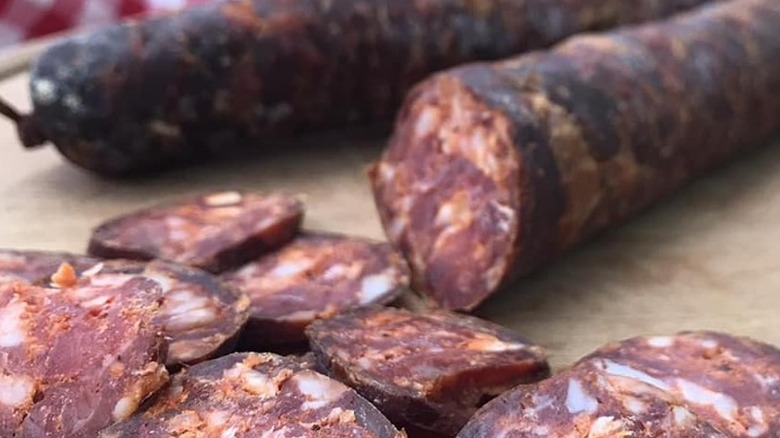15 Serbian Dishes You Need To Try At Least Once
Certain types of cuisine, such as Italian and Chinese, have long been popular with U.S. diners. Others, particularly those from Southeast Asia and Latin America, have been making great inroads in recent years. The foods of Central and Eastern European, however, have yet to get major time in the spotlight, which is too bad since we're missing out on all manner of unexpected delights.
While Serbian cuisine may not be the kind of thing that merits its own category on GrubHub, you don't need to travel to Belgrade to experience it. There are a number of Serbian restaurants and grocers in areas where the Serbian diaspora is most heavily settled, including Chicago, Milwaukee, and New York. Serbian cuisine is admittedly meat-heavy, but that's not the only thing that this style of cooking has to offer. In fact, only five dishes on this list are particularly meat-centric, while you'll also find vegetables, cheeses, bread, and several delicious desserts spread within.
1. Ajvar
Ajvar is not a strictly Serbian thing. Instead, it's a pan-Balkan dish popular in Albania, Macedonia, and other countries throughout the region. Still, the first known recipe was published in a Serbian cookbook in the 19th century, so perhaps the Serbs do have some claim to the dish (via BBC). From the name, however, it seems that ajvar may have Turkish roots, as hayvar is the Turkish word for caviar.
Despite the fact that ajvar is often referred to as "Balkan caviar," there's nothing fishy about it. The main ingredient is roasted red peppers with oil, vinegar, and salt, although the dish may also include garlic and eggplant. Ajvar is considered to be a condiment, one that is often served alongside meat. According to The New York Times, Serbian restaurant Kafana always tops its burgers (pljeskavica, see below) with ajvar. At the same time, Miami's Rakija Lounge uses it to accompany its sausages along with all the rest of the meats on its mixed grill. Fortunately for non-meat eaters, ajvar can be eaten atop sliced bread or crostini or used as a dip for crudites or chips.
2. Bundevara
While we tend to think of pumpkin pie as the most all-American of desserts (far more American than cooking an apple pie, if truth be told), the Serbs also have their own version of this fall favorite. Serbia's answer to pumpkin pie is a pastry called bundevara, made with flaky phyllo dough, which is the same stuff used in baklava (a pastry that if not unknown in the Balkan region).
Bundevara's filling, according to the International Centre for Black Sea Studies, is made from grated pumpkin flavored with sugar and seasonings such as nutmeg and cinnamon (apparently, pumpkin pie spice is a worldwide phenomenon), with raisins as an optional add-in. The filled bundevara is usually sprinkled with powdered sugar and can be eaten either warm or cold. As per Alternative Serbia, bundevara makes for a great vegan dessert choice in a country not known for its plant-based options. Despite being pastry-encased, bundevara is dairy-free because phyllo dough, as opposed to puff pastry, tends to be made with oil instead of butter.
3. Burek
There are a lot of things that make burek so special. Like ajvar, it is another pan-Slavic dish that most likely originated in Turkey (via History Today). It's also somewhat similar to bundevara in that it is a pastry made with a filling wrapped in phyllo dough, although that filling is typically savory rather than sweet. In fact, in certain quarters, there are those who insist that all bureks must be meat-filled, but actually, Serbia is not one of those places. Nor are Serbian bureks always coil-shaped, as is the case in Bosnia (via Serbia.com). Serbian bureks can be either coiled or quarter-cut circles and can be filled with cheese instead of or in addition to meat. A cheesy burek, according to Reddit, is known as burek sa sirom.
Burek is often eaten as a breakfast food, perhaps accompanied by yogurt and, of course, a strong cup of Serbian coffee. It also appears on dinner menus, as well, with Milwaukee's Old Town Serbian Gourmet offering four different types of burek: beef, cheese, beef and cheese, and cheese and spinach. However, the restaurant notes that a good burek takes time to prepare, but you can be assured it's well worth the wait. If you do not live anywhere near Old Town Serbian or any other similar establishment, you can still experience the joy of a good burek by ordering a frozen one shipped from a grocer specializing in European imports, such as Parthenon Foods.
4. Ćevapi
At last, we get to one of those meat dishes for which Serbia is known: ćevapi, which are grilled, skinless sausages. Okay, we admit that ćevapi, according to Croatia Week, ćevapi is also Turkish (or Ottoman, really) in origin and is known throughout the Baltic region — as is the case for so many of Serbian cooking's greatest hits. Still, ćevapi is one of Serbia's most popular dishes, and no discussion of that country's food would be complete without giving these sausages their due.
As per Foodie Advice, Serbian ćevapi are typically made from pork, lamb, beef, or a mixture of any of these three types of meat. They will frequently be served on flatbread and may come topped with cheese, onions, and/or sour cream. Milwaukee's Three Brothers Restaurant prefers a more minimalist approach, with its ćevapčići, as it calls them, accompanied only by raw onions and tomato. At NYC's Kafana, the ćevapi come with nothing more than onions and parsley, but the food critic from The New York Times writes that the sausages are "full of character and flavor all on their own," so they don't need any embellishment.
5. Gibanica
Gibanica is yet another phyllo-based pastry, this one made with cheese. Although similar cheesy pastries are known throughout the Balkans and other countries, the Astoria Cafe and Bakery (via YouTube) says that gibanica is regarded as being a traditional Serbian dish. To make gibanica, sheets of phyllo dough are layered with a cheese and egg filling. As for the type of cheese, this may vary with region, but Wisegeek mentions feta, cottage cheese, and ricotta as possibilities. Kafana uses feta in its gibanica for a dish that The New York Times describes as "spongy and cakelike" rather than flaky as many phyllo-based pastries tend to be.
Gibanica can either be a sweet dish or a savory one, depending on the recipe. It may be a breakfast food or possibly a snack, or an appetizer. In this last-named instance, it would most likely be an unsweetened version, but for breakfast or snacking purposes, you could really go either way.
6. Karađorđeva šnicla
Karađorđeva šnicla is well and truly Serbian. It's a fairly recent dish, having been created in 1956 by a culinary professional named Milovan "Mića" Stojanović, who also went on to work as a personal chef for the Yugoslavian head of state, Tito (via Nova.rs). The dish, despite its Cold War provenance, was given a proper Serbian name after the Karadjordjević dynasty, the descendants of a Serbian rebel leader named Karađorđe. (These being the Serbian royals who ruled over Yugoslavia from the 19th century to 1945 when the country traded its monarchy for a Communist government.) Although you'll find chefs improvising with the recipe today, Stojanović notes that his originally chosen components of the Karađorđe schnitzel, veal, cream, mayonnaise, and lemon, are the way it should be done.
Foodie Advice describes Karađorđeva šnicla as a breaded, cheese-stuffed pork or veal cutlet that is fried and topped with tartar sauce. Bite Mojo adds the info that it was actually created by accident, or rather, as the result of a restaurant kitchen that did not have the proper ingredients to prepare the Chicken Kiev that was requested by none other than a family member of Tito. It does, in fact, bear some similarity to that Russian dish, perhaps crossed with wiener schnitzel. Kafana plays up the resemblance to the former, though, as its version of karađorđeva šnicla is stuffed with ham as well as cheese.
7. Lepinja
Lepinja is a Serbian flatbread that is somewhat similar to pita bread. Although flat, it is made with yeast and puffs up a bit when baked at high heat. Once it is sliced open, it creates a "pocket" that can then be stuffed with sandwich fillings, such as in the Serbian version of croque monsieur, called komplet lepinja (via Atlas Obscura). Lepinja is closely related to another Balkan flatbread called samun, and, in fact, according to AZ Central, the names are sometimes used interchangeably. While lepinja itself is vegan (the ingredients are flour, salt, and water), one of its primary purposes is to be served with meats like ćevapi and the Serbian burgers known as pljeskavica
Lepinja, however, is more than just Serbia's answer to the hot dog or hamburger bun, as this bread can stand on its own without meat. The New York Times says that Kafana typically grills its lepinja and tops it with cheese, while this flatbread can also make a good dipper for ajvar or even be put to use as the base for a Balkan spin on pizza. If you'd like to try lepinja for yourself, you could always attempt to bake your own, but if you'd rather not mess with yeast dough, it can be purchased frozen from Parthenon Foods.
8. Palačinke
Palačinke is the Serbian version of crepes and can be a popular form of fast food. One Serbian quick-serve restaurant, Balans Palačinke, seems to be a hit with tourists as well as locals. A 5-star Trip Advisor review calls its product "The best pancakes in Serbia," while another (also 5 stars) notes that the place always draws a crowd.
Palačinke is often served as a dessert, but just as with their French counterpart, they can have savory fillings, as well. According to Fine Dining Lovers, one distinction between the French and East European styles of this dessert is the moment in which the batter is used. Crepes require a batter to sit, while palačinke batter is used as soon as it is made.
Chicago's Beograd offers both types of palačinke on its menu. While the restaurant lists these pancakes under the easier-to-pronounce heading of crepes, the dish is definitely prepared in the Serbian style rather than the French one. Beograd's dessert palačinke are filled with fruit jam, honey, Nutella, or the sweet Serbian spread called Eurocrem, with add-ons including nuts, whipped cream, ice cream, fruit, and cookies (Serbia's own Bambi brand). The savory crepes, which could be an appetizer or entrée, include a choice of cheese and meat fillings such as spicy pepperoni, grilled chicken, and feta cheese with vegetables.
9. Pljeskavica
If ćevapi is Serbia's answer to the hot dog, then pljeskavica is its take on the hamburger. As per Foodie Advice, this Balkan favorite is a patty of seasoned ground meat, and the typical version is said to be a mixture of pork, lamb, and beef. Definitions, however, define the dish (as is its mission) as being a combination of at least two of the following: beef, lamb, pork, or veal. There are also a number of variant versions, including hajdučka pljeskavica, which is made with ground beef and smoked pork, and sarska pleskavica, which is Serbia's own "Jucy Lucy," this being a cheese-stuffed beef patty. Pleskavica may also be mixed with chopped onions before grilling.
Pleskavica need not always come on a bun. However, The New York Times says that in the U.S., the patties are now typically stuffed inside lepinja or even pita bread to better resemble American-style burgers. Bunless or not, pleskavica may also be topped with various condiments, including sour cream, cheese, hot peppers, onions, cucumbers, or ajvar.
10. Prebranac
Not only do Serbian have their own take on burgers, but they also have their own version of baked beans. Prebranac consists of beans flavored with onions and Hungarian-style paprika and baked until they are somewhat creamy and dry in texture. The New York Times spills the beans on what type of legumes are used at Kafana — lima beans, it says, are what go into the restaurant's prebranac, although Alternative Serbia says that white beans can be used, as well.
Serbia being the carnivore's paradise that it is, prebranac is frequently served as a side dish, as is the case with American baked beans. It can also be eaten as a vegan main dish as well, perhaps paired with a piece of lepinja or some other type of bread. For non-vegetarians, there's a version of the dish called prebranac sa kobasicom that is available from Moskva Caffe in Westmont, Illinois. While the restaurant's online menu doesn't offer any explanation, Google Translate supplies the helpful information that kobasicom is the Serbian word for sausage.
11. Pule
Okay, we'll go ahead and admit it from the outset — pule is one of those foods that, while you certainly should try if you ever get the chance, is something you're probably never going to even get within sniffing distance of. Well, not unless you're pals with Novak Djokovic, the Serbian tennis star who was once rumored to have bought up the entire supply of this unique cheese (although he says he didn't).
So what makes pule so rare that it is considered to be the most expensive cheese in the world? It is made from donkeys' milk, but the milk can't come from just any old donkey. Instead, only the endangered Balkan donkeys need apply, and even then, the cheese can only be produced by one single solitary cheesemaker. In addition, this type of donkey produces precious little milk, magnitudes less than cows do, and with fewer fat solids in each milliliter. So, it takes longer overall (via Atlas Obscura). We do not know whether Slobodan Simic plans to pass on his secret cheese recipe before he eventually passes away. Maybe he'll just let his cheese die out when he does. Still, there is doubt whether it's even possible to make cheese out of donkey milk in the first place, so there's a chance this elusive cheese is just a rural legend. Should you ever track down what may be Serbia's best-known least-known food, though, we hear it goes great with barbecued unicorn.
12. Rakija
Rakija spirit is a Serbian specialty that's often referred to as Balkan moonshine. Commercial versions of this fruit brandy are widely available, however, and it's not against the law in Serbia to distill it as homemade hooch. In recent years, rakija has even become a bit trendy in the U.S., with San Antonio-based Dorcol Distilling making small-batch craft rakija out of apricots and Washington, D.C.'s Ambar offering a wide range of rakija made from apples, apricots, cherries, honey, pears, plums, quinces, and raspberries. Rakija Lounge in Miami also has its own homemade rakija, distilled from apricots, pears, plums, quinces, and oak barrel-aged grapes.
Rakija is meant for sipping, not slamming back, as the flavor is something to savor. Rakija should also not be served too cold — in a thread devoted to this topic, one Redditor suggested that the room-temperature spirit should be poured into a chilled glass. As per the Slow Travel Blog, rakija can even be warmed up to make a winter drink, something that is popular in Serbia.
13. Ražnjići
One type of food that's popular all over the world falls under the general heading of "things on sticks" or, to be more specific, "meat on sticks." In the U.S., we have that state fair favorite, the corn dog, while the Middle East has its shish kebab recipes, Japan its yakitori, Indonesia its satay, and Greece its souvlaki. In Serbia, their version is called ražnjići, something that World Food Guide explains is most often made from either pork or beef, depending on local style. Religious practices may also play into the type of meat used since while the majority of Serbians are Eastern Orthodox, approximately 3% of the population is Muslim, and Islam is the dominant religion in neighboring Bosnia. For Muslims, of course, non-pork ražnjići would be preferred.
At Three Brothers Restaurant in Milwaukee, pork-based ražnjići is what's on the menu, and it comes served with raw onion and tomatoes. NYC's Kafana, however, offers pileci ražnjići, a version made with grilled chicken. Chicken ražnjići has also been known to feature on the menu at Restaurant Cosmopolitan in Alexandria, Virginia, as well (via Single Platform).
14. Sarma
While stuffed cabbage rolls may not be a universal dish, they are certainly popular throughout eastern Europe. Poland has its golumpki and Lithuania its balandeliai, there's Ukrainian stuffed cabbage called holubtsi, and Serbia has its sarma. As Foodie Advice explains it, sarma typically consists of cabbage leaves filled with a mixture of rice and both ground beef and pork, then simmered in a sauce flavored with both paprika and bacon. While this description makes sarma sound like a carnivore's delight, Alternative Serbia explains that there's a version called posna sarma where the meats are replaced with vegetables, thus making for a vegan-friendly (and more Muslim-friendly) entrée.
Other variations in sarma preparation may involve the cabbage itself. While Milwaukee's Three Brothers Restaurant makes its sarma with pickled cabbage, across town at Old Town Serbian Gourmet, the cabbage is fermented instead. Old Town also goes for a much more meaty version of the dish, one filled with beef, pork, sausage, and bacon and cooked in smoked pork sauce. Three Brothers sticks with a more basic beef and rice filling, although you do get potato dumplings on the side.
15. Sremska Ljuta Kobasica
Sremska Ljuta Kobasica is quite a mouthful in both senses of the word. It's a smoked pork or pork-and-beef sausage spiced with hot paprika that gives it a reddish hue as well as a fiery flavor. (Kafana even ups the ante with the addition of jalapenos.) As for the name, let's break it down: Google Translate tells us that ljuta means "angry," so we'll assume that refers to the hot peppers, while kobasica simply means sausage. Sremska, however, indicates that the sausage originates in Serbia's Srem District (via Townsend Butchers).
Sremska ljuta kobasica is a dry-style sausage along the lines of salami or pepperoni, something that makes it less perishable than fresh sausage and more suited for importing. There is, however, at least one U.S.-based manufacturer of this item, George's Brand Meats, in Franklin Park, Illinois. It's Sremska ljuta kobasica is available to order online and can also be purchased via Parthenon Foods.
